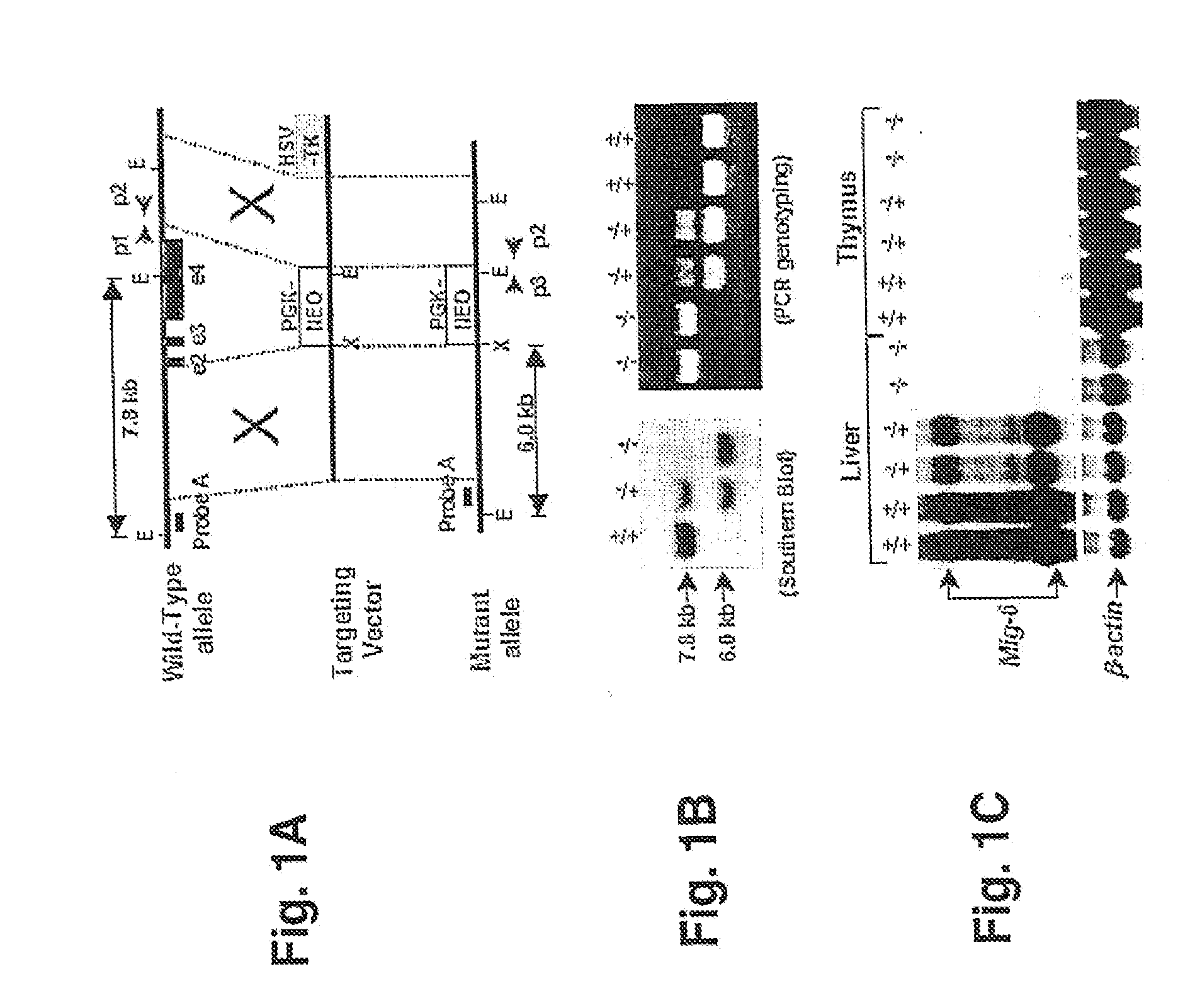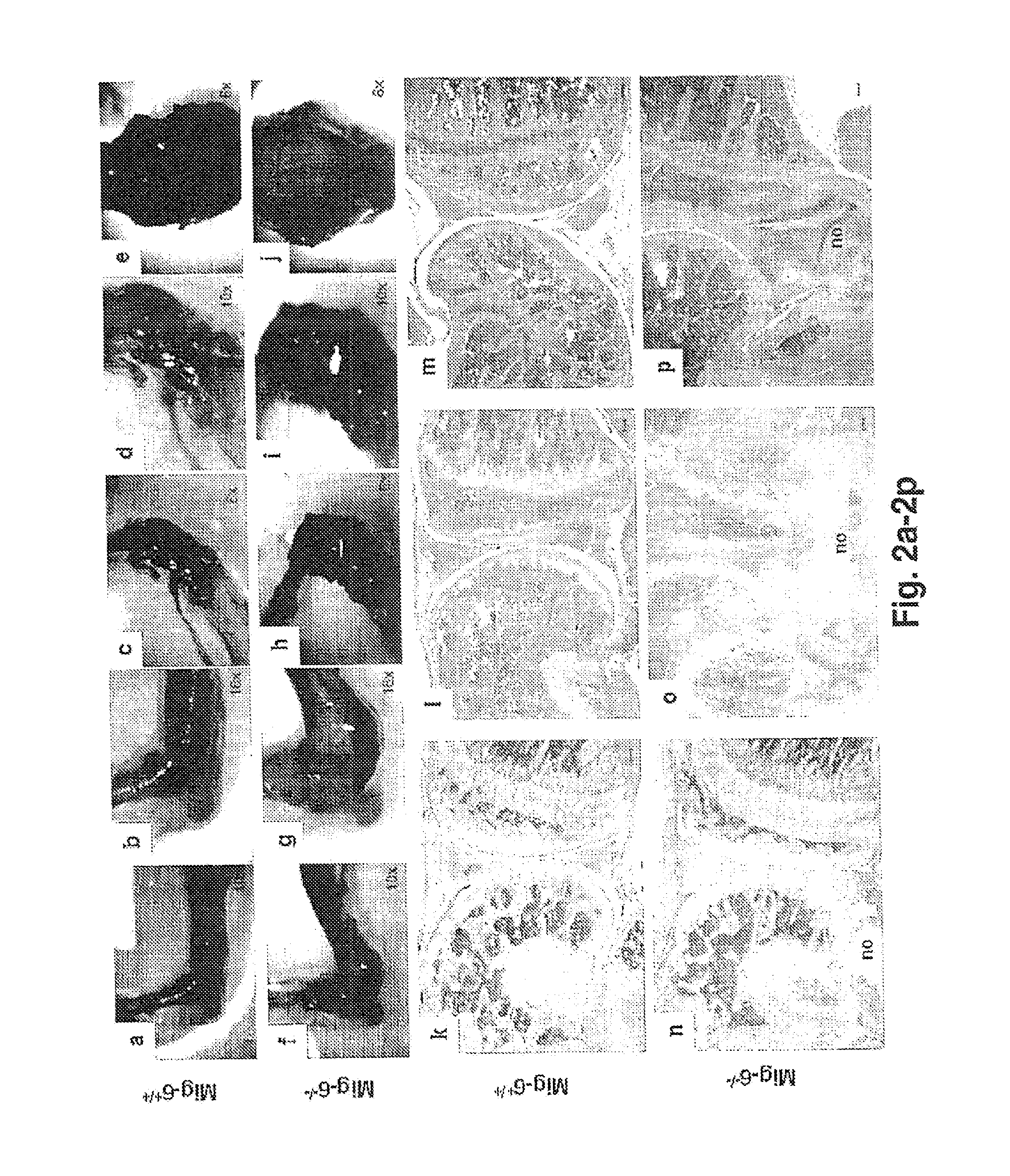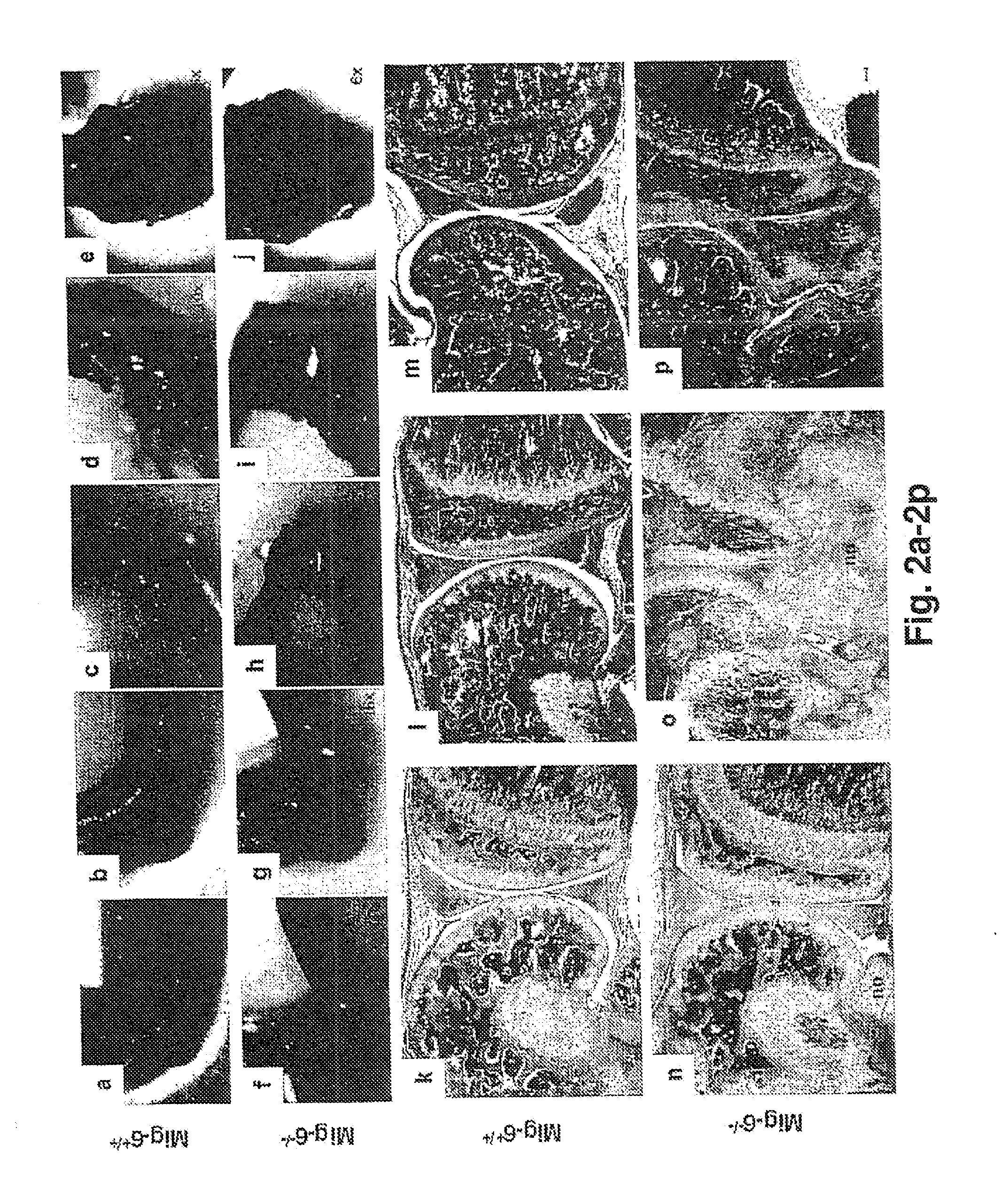Mig-6 Knockout Mice and Elucidation of Association of Mig-6 With Early Onset Degenerative Joint Disease and Role As A Tumor Suppressor
a tumor suppressor and mouse technology, applied in the field of molecular biology and medicine, can solve the problems of affecting the quality of life, acute and chronic pain and disability, and astronomical costs of pain relief medications, so as to delay development, delay the effect of development, and evaluating the appearance, growth or metastasis rate, growth rate, and the time of appearan
- Summary
- Abstract
- Description
- Claims
- Application Information
AI Technical Summary
Benefits of technology
Problems solved by technology
Method used
Image
Examples
example i
Mig-6 Knockout Mice: Materials and Methods
[0112]Mice and Genotyping.
[0113]To generate Mig-6 knockout mice, the present inventors constructed a Mig-6 targeting vector or knockout vector (FIG. 1A) by inserting a 5 kb genomic fragment upstream of exon 2 (designated e2) and a 3 kb genomic fragment downstream of exon 4 (designated e4) into the pPNT vector (Tybulewicz, V et al., (1991) Cell 65:1153-63), respectively 5′ to and 3′ to the PGK-NEO cassette.
[0114]As shown in FIG. 1A, this knockout vector or “targeting vector” includes the following components (in the 5′-3′ direction):[0115](1) The 5′-homologous recombination sequence derived from mouse Mig-6 genomic DNA; this is a ˜5-kb genomic fragment mostly upstream of exon 2 (though it includes a short sequence from exon 2). This fragment has the following sequence [SEQ ID NO:19]. The bold / underscored 3′ sequence corresponds to nt's from exon 2.
AGGTCATCTA GTGGAGGCAA GAACACACAA ACCATCCTTT CTTTGCATCC TTTTGGACAGCATTTATGAA ATATTTGCTG AAGCTATCA...
example ii
Early Onset Osteoarthritis in Mig-6 Knockout Mice
[0128]Mig-6 deficient mice were generated by conventional gene targeting technology by replacing the entire coding region of Mig-6 with PGK-Neo cassette / construct (FIG. 1A). The loss of wild type alleles of Mig-6 was determined by Southern Blot analysis using “Probe A” and by PCR-based genotyping (FIG. 1B).
[0129]Probe A has the following nucleotide sequence [SEQ ID NO:21]:
TACCTGCCTT ATTCAGAGGA GTCAAGTGTG TATCTTAAGT CATTTTGTTC CAGTAATTTGAAGAGCCTAA GACTTTAAAA GAGAGGCTGT GGTATGGTCG AGAGCATAAA CTTTGAGGCCAAGCTTCCTG AAGTAAGCCG TGGCATTACT GTGGCTCACC GGAGCCGAGT CAGATCTAGTTGCAGAAGCT CCTCGTCTGT CATTGAGAGT AGTGTCCCAC CTACCTTAGG GCTGCTACAAGGATAAAACT GAAAACCTTC CTGACAGACA GTATCCTATG AATGTCATTA TCATCACCTATGTATTAATT TTAACTCTCC TGAGTTGTCC ATTGGGTTAT TTAAATGCTT GTTAAATAAACTTGAAGTTT TAAAGACTCA TTTCCCATCA TTAGCCCATT GTGGTCATTG TCATTAAGATTACAACAGAA TCCACACATC GTTCACAGGT ACAGTGCATT GCATATGTCG GAAAGAAATGCTCTTCCATG CCGTGTGTGC TTGCCTGTGT CTGTGGATGG TACTGTTGA...
example iii
Mig-6 and Tumor Suppressor Gene Activity: Experimental Procedures
Human Lung Cancer Cell Lines and Cell Culture
[0142]The nine non-small cell lung cancer (NSCLC) cell lines EKVX, HOP62, HOP92, NCI-H23, NCI-H226, NCI-H322M, NCI-H446, NCI-H522, and A549 were derived from the NCI 60 cell lines. The cells were cultured in RPMI 1640 medium supplemented with 10% fetal bovine serum.
Mutational Analysis of Mig-6
[0143]Human lung cancer and normal control tissue was obtained through the Cooperative Human Tissue Network (CHTN). Genomic DNA was isolated from human cell lines and tissues. Polymerase chain reaction (PCR) was performed to amplify the entire coding regions of Mig-6 (exons 2, 3, and partial exon 4) using three primer pairs. Primers used for screening genomic DNA mutations in the coding region of human Mig-6 are as follows. The same set of primers is also used for sequencing PCR products for determining if there is a mutation or not in the coding region of human Mig-6.
(1) Pair-I for amp...
PUM
 Login to View More
Login to View More Abstract
Description
Claims
Application Information
 Login to View More
Login to View More - R&D
- Intellectual Property
- Life Sciences
- Materials
- Tech Scout
- Unparalleled Data Quality
- Higher Quality Content
- 60% Fewer Hallucinations
Browse by: Latest US Patents, China's latest patents, Technical Efficacy Thesaurus, Application Domain, Technology Topic, Popular Technical Reports.
© 2025 PatSnap. All rights reserved.Legal|Privacy policy|Modern Slavery Act Transparency Statement|Sitemap|About US| Contact US: help@patsnap.com



